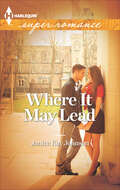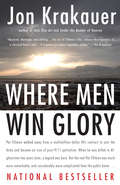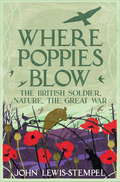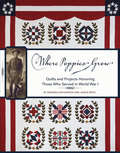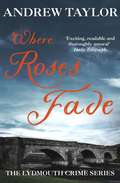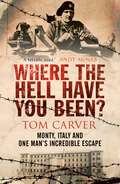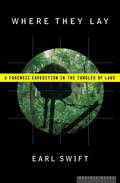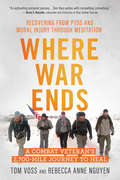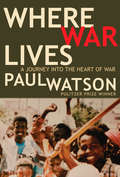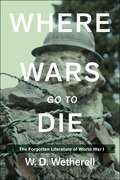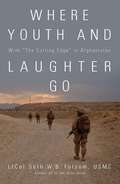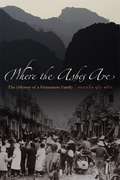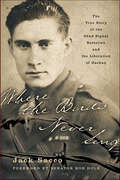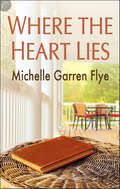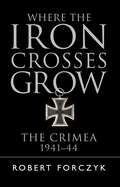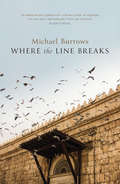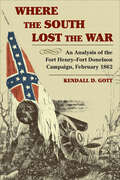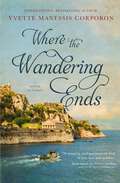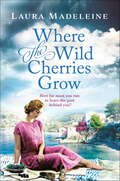- Table View
- List View
Where Is Area 51? (Where Is?)
by Tim Foley Who Hq Paula K. ManzaneroYou'll find it on a map--but you'll never get anywhere near this top secret military base. What exactly is going on there?Is Area 51 a top secret military base that lies in the middle of the barren Nevada desert? Or could it actually be a facility for examining aliens and their spaceships? People can't drive anywhere close to it; the US government rarely acknowledges its existence; and until recently, the airspace overhead was restricted! Conspiracy theories abound about what goes on at Area 51, especially since 1947 when strange objects were found in the middle of a field in Roswell, New Mexico. Author Paula K. Manzanero explains why Area 51 was established and reveals the mystery behind those unidentified flying objects in the sky. Check out this book and decide what you believe.
Where It May Lead
by Janice Kay JohnsonA revelation that could ruin everything!Instant attraction is the stuff of books and movies. Or so Alumni Relations Director Madison Laclaire believes...until she meets Detective John "Troy" Troyer. From closing down the restaurant on their first date to sharing steamy looks in meetings, Madison is completely into Troy. Even better, the feelings are mutual. Once this alumni weekend is over, they can pursue the plans they have for each other.But those plans get sidelined when the college opens a decades-old time capsule. Inside, a student confesses knowledge about the campus's only murder-an unsolved murder. Worse, Troy's investigation points to Madison's father as a suspect. Suddenly her loyalties are split. And making the wrong choice could cost her a future with Troy....
Where Men Win Glory: The Odyssey of Pat Tillman
by Jon KrakauerThis edition has been updated to reflect new developments and includes new material obtained through the Freedom of Information Act. Pat Tillman walked away from a multimillion-dollar NFL contract to join the Army and became an icon of post-9/11 patriotism. When he was killed in Afghanistan two years later, a legend was born. But the real Pat Tillman was much more remarkable, and considerably more complicated than the public knew. A stunning account of a remarkable young man's heroic life and death, from the bestselling author of Into the Wild, Into Thin Air, and Under the Banner of Heaven.From the Trade Paperback edition.
Where Poppies Blow: The British Soldier, Nature, the Great War
by John Lewis-StempelWinner of the 2017 Wainwright Golden Beer Book Prize for nature writingThe natural history of the Western Front during the First World War'If it weren't for the birds, what a hell it would be.'During the Great War, soldiers lived inside the ground, closer to nature than many humans had lived for centuries. Animals provided comfort and interest to fill the blank hours in the trenches - bird-watching, for instance, was probably the single most popular hobby among officers. Soldiers went fishing in flooded shell holes, shot hares in no-man's land for the pot, and planted gardens in their trenches and billets. Nature was also sometimes a curse - rats, spiders and lice abounded, and disease could be biblical.But above all, nature healed, and, despite the bullets and blood, it inspired men to endure. Where Poppies Blow is the unique story of how nature gave the British soldiers of the Great War a reason to fight, and the will to go on.
Where Poppies Blow: The British Soldier, Nature, the Great War
by John Lewis-StempelWinner of the 2017 Wainwright Golden Beer Book Prize for nature writingThe natural history of the Western Front during the First World War'If it weren't for the birds, what a hell it would be.'During the Great War, soldiers lived inside the ground, closer to nature than many humans had lived for centuries. Animals provided comfort and interest to fill the blank hours in the trenches - bird-watching, for instance, was probably the single most popular hobby among officers. Soldiers went fishing in flooded shell holes, shot hares in no-man's land for the pot, and planted gardens in their trenches and billets. Nature was also sometimes a curse - rats, spiders and lice abounded, and disease could be biblical.But above all, nature healed, and, despite the bullets and blood, it inspired men to endure. Where Poppies Blow is the unique story of how nature gave the British soldiers of the Great War a reason to fight, and the will to go on.
Where Poppies Grow: A World War I Companion
by Linda GranfieldFinalist for the Silver Birch Award Winner of the 2002 Information Book Award When World War I began in 1914, no one knew that millions of young people would die in the agonizing years ahead. No one imagined the effect it would have on family life, or that whole villages would disappear, or that entire nations would be changed forever. They believed their sons and daughters, mothers and fathers would be home by Christmas. They were tragically mistaken. With photos, memorabilia, and anecdotes, Linda Granfield brings us face-to-face with people from all walks of life who risked everything for their country. These painstakingly-gathered bits and pieces are remnants of conflict on a scale never before witnessed. Hastily-penned letters, notes written in code, and prayers for deliverance form an eloquent portrait of humanity, and a startling comment on the devastation of war.
Where Poppies Grow: Quilts and Projects Honoring Those Who Served in World War I
by Denniele Bohannon Janice BritzQuilts and projects rooted in history and honoring heroes.Denniele Bohannon’s great-grandfather Almo O’Kell served as a medic in World War I and was one of the many soldiers who never came home. Together with Janice Britz, she created the Kansas City Star’s block-of-the-month quilt, Remembering Almo, to honor those who served their country at the centennial of the Great War.Two color variations and setting options are given for the main quilt. Three more striking quilts, two variations of a table runner and a poppy pin and pincushion round out the projects. Also included is information about Almo’s life, with photos and brief excerpts from his letters.
Where Roses Fade: The Lydmouth Crime Series Book 5
by Andrew Taylor'Andrew Taylor is a master story-teller' Daily Telegraph From the No.1 bestselling author of The Ashes of London and The Fire Court, this is the fifth instalment in the acclaimed Lydmouth seriesWhen Mattie Harris's body is found drowned in the river, everyone in Lydmouth knows something is wrong. Mattie wasn't a swimmer - it can't have been a simple accident. She was drunk on the last night of her life - could she have fallen in? Or was she pushed? Mattie was a waitress, of no importance at all, so when Lydmouth's most prominent citizens become very anxious to establish that her death was accidental, Jill Francis's suspicions become roused. In the meantime she is becoming ever closer to Inspector Richard Thornhill, and discovering that the living have as many secrets as the dead...'An excellent writer. He plots with care and intelligence and the solution to the mystery is satisfyingly chilling' The Times'The most under-rated crime writer in Britain today' Val McDermid 'There is no denying Taylor's talent, his prose exudes a quality uncommon among his contemporaries' Time Out
Where Roses Fade: The Lydmouth Crime Series Book 5
by Andrew Taylor'Andrew Taylor is a master story-teller' Daily Telegraph From the No.1 bestselling author of The Ashes of London and The Fire Court, this is the fifth instalment in the acclaimed Lydmouth seriesWhen Mattie Harris's body is found drowned in the river, everyone in Lydmouth knows something is wrong. Mattie wasn't a swimmer - it can't have been a simple accident. She was drunk on the last night of her life - could she have fallen in? Or was she pushed? Mattie was a waitress, of no importance at all, so when Lydmouth's most prominent citizens become very anxious to establish that her death was accidental, Jill Francis's suspicions become roused. In the meantime she is becoming ever closer to Inspector Richard Thornhill, and discovering that the living have as many secrets as the dead...'An excellent writer. He plots with care and intelligence and the solution to the mystery is satisfyingly chilling' The Times'The most under-rated crime writer in Britain today' Val McDermid 'There is no denying Taylor's talent, his prose exudes a quality uncommon among his contemporaries' Time Out
Where The Hell Have You Been?: Monty, Italy and One Man's Incredible Escape
by Tom CarverIn November 1942 a young British army officer was captured. This gripping story tells of Richard"s internment in a POW camp in northern Italy and of his subsequent escape.
Where The Hell Have You Been?: Monty, Italy and One Man's Incredible Escape
by Tom CarverIn November 1942 a young British army officer was captured. This gripping story tells of Richard"s internment in a POW camp in northern Italy and of his subsequent escape.
Where They Lay: A Forensic Expedition in the Jungles of Laos
by Earl SwiftPEN/Martha Albrand Award Finalist: The suspenseful, &“poignant&” true story of the search for an American military pilot&’s remains in Southeast Asia (James Bradley, author of Flags of Our Fathers). Where They Lay is both an account of an elite military team&’s high-tech, high-risk search for a Vietnam War pilot&’s remains, and a moving retelling of his intense final hours. In far-flung rain forests and its futuristic lab near Pearl Harbor, the Central Identification Laboratory (CILHI) strives to recover and identify the bodies of fighting men who never came home from America&’s wars. Its mission combines old-fashioned bushwhacking and detective work with the latest in forensic technology. Earl Swift accompanies a CILHI team into the Laotian jungle on a search for the remains of Maj. Jack Barker and his three-man crew, whose chopper went down in a fireball more than thirty years ago. He interweaves the story of the recovery team&’s work with a tense account of Barker&’s fatal attempt to rescue trapped soldiers during the largest helicopter assault in history. The first reporter ever allowed to follow a recovery mission—as these archaeological digs are called—in its entirety, Swift got his hands dirty, combing the jungle floor for clues amid vipers, monsoons, and unexploded bombs. In this &“hands-on, thought-provoking&” account, he reveals the dedication not only of the fallen servicemen but of the scientists who search for them, and explores questions about the cost of these missions and the corruption among native officials that may compromise them (Minneapolis Star-Tribune). &“Informative . . . He interweaves accounts of a generation&’s worth of site sifting, involving everything from the most basic shovel work to satellite relaying of computer data, with the whole history of the remains-recovery project . . . He also paints a vivid portrait of deeply impoverished Laos, the sometimes helpful Laotians and the military professionals and technical specialists who make up the search teams.&” —Publishers Weekly &“An unusual tale of war and remembrance.&” —Kirkus Reviews
Where War Ends: A Combat Veteran’s 2,700-Mile Journey to Heal — Recovering from PTSD and Moral Injury through Meditation
by Tom Voss Rebecca Anne NguyenAn Iraq War veteran’s riveting journey from suicidal despair to hope After serving in a scout-sniper platoon in Mosul, Tom Voss came home carrying invisible wounds of war — the memory of doing or witnessing things that went against his fundamental beliefs. This was not a physical injury that could heal with medication and time but a “moral injury” — a wound to the soul that eventually urged him toward suicide. Desperate for relief from the pain and guilt that haunted him, Voss embarked on a 2,700-mile journey across America, walking from Milwaukee, Wisconsin, to the Pacific Ocean with a fellow veteran. Readers walk with these men as they meet other veterans, Native American healers, and spiritual teachers who appear in the most unexpected forms. At the end of their trek, Voss realizes he is really just beginning his healing. He pursues meditation training and discovers sacred breathing techniques that shatter his understanding of war and himself, and move him from despair to hope. Voss’s story will give inspiration to veterans, their friends and family, and survivors of all kinds.
Where War Lives: A Journey into the Heart of War
by Paul WatsonA Pulitzer Prize–winning journalist takes us on a personal and historic journey from Mogadishu through Rwanda to Afghanistan and Iraq.With the click of a shutter the world came to know Staff Sgt. William David Cleveland Jr. as a desecrated corpse. In the split-second that Paul Watson had to choose between pressing the shutter release or turning away, the world went quiet and Watson heard Cleveland whisper: “If you do this, I will own you forever.” And he has.Paul Watson was born a rebel with one hand, who grew up thinking it took two to fire an assault rifle, or play jazz piano. So he became a journalist. At first, he loved war. He fed his lust for the bang-bang, by spending vacations with guerilla fighters in Angola, Eritrea, Sudan, and Somalia, and writing about conflicts on the frontlines of the Cold War. Soon he graduated to assignments covering some of the world’s most important conflicts, including South Africa, Rwanda, Afghanistan, and Iraq.Watson reported on Osama bin Laden’s first battlefield victory in Somalia. Unwittingly, Watson’s Pulitzer Prize–winning photo of Staff Sgt. David Cleveland—whose Black Hawk was shot down over the streets of Mogadishu—helped hand bin Laden one of his earliest propaganda coups, one that proved barbarity is a powerful weapon in a modern media war. Public outrage over the pictures of Cleveland’s corpse forced President Clinton to order the world’s most powerful military into retreat. With each new beheading announced on the news, Watson wonders whether he helped teach the terrorists one of their most valuable lessons. Much more than a journalist’s memoir, Where War Lives connects the dots of the historic continuum from Mogadishu through Rwanda to Afghanistan and Iraq.
Where Wars Go to Die: The Forgotten Literature of World War I
by W. D. WetherellAs the world commemorates the hundredth anniversary of World War I, the literary canon of the war has consolidated around the memoirs written in the years after the Armistice by soldier-writers who served in the trenches. <P><P>Another kind of Great War literature has been almost entirely ignored: the books written and published during the war by the greatest English, American, French, and German writers at work--books that show us how the best, most influential writers responded to an overpowering human and cultural catastrophe. Where Wars Go to Die: The Forgotten Literature of World War I explores this little-known cache of contemporary writings by the greatest novelists, poets, playwrights, and essayists of the war years, examining their interpretations and responses, weaving excerpts and quotations from their books into a narrative that focuses on the various ways civilian writers responded to an overwhelming historical reality. The authors whose war writings are presented include George Bernard Shaw, Henry James, Joseph Conrad, H. G. Wells, Edith Wharton, Maurice Maeterlinck, Henri Bergson, W. E. B. Du Bois, Romain Rolland, Thomas Mann, Thomas Hardy, May Sinclair, W. B. Yeats, Ring Lardner, Reinhold Niebuhr, and dozens more of equal stature. Intended for the general reader as much as the specialist, Where Wars Go to Die breaks important new ground in the history and literature of World War I. Skyhorse Publishing, as well as our Arcade imprint, are proud to publish a broad range of books for readers interested in history--books about World War II, the Third Reich, Hitler and his henchmen, the JFK assassination, conspiracies, the American Civil War, the American Revolution, gladiators, Vikings, ancient Rome, medieval times, the old West, and much more. While not every title we publish becomes a New York Times bestseller or a national bestseller, we are committed to books on subjects that are sometimes overlooked and to authors whose work might not otherwise find a home.
Where Youth and Laughter Go
by LtCol Seth W. B. FolsomWhere Youth and Laughter Go: With "The Cutting Edge” in Afghanistan completes LtCol Seth Folsom’s recounting of his personal experiences in command over a decade of war. It is the culminating chapter of a trilogy that began with The Highway War: A Marine Company Commander in Iraq in 2006 and continued with In the Gray Area: A Marine Advisor Team at War in 2010. The chronicle of Folsom’s command of 3rd Battalion, 7th Marine Regiment, "The Cutting Edge,” and his harrowing deployment to Afghanistan’s volatile Sangin District presents a deeper look into the complexities and perils of modern counterinsurgency operations in America’s longest war. Charged with the daunting task of pacifying a region with a long history of violence and instability, Folsom and his Marines struggled daily to wage a dynamic campaign against the shadowy enemy force that held Sangin’s population firmly in its grip. With peace and stability always teetering on the brink of collapse, the Marines of "The Cutting Edge” confronted their own mortality as they conducted endless patrols through Sangin’s minefields while fighting to win the hearts and minds of the Afghan villagers. No other books have been published from the perspective of a Marine infantry battalion commander in Afghanistan. It was Folsom’s job, as the unit commander, to lead his Marines under impossible circumstances. LtCol Folsom made the unusual decision to patrol with his rifle squads every day through Sangin, where his Marines dodged improvised explosive devices and sniper fire from an invisible enemy. As his tour progressed and casualties mounted, he found his objectivity evaporating and the love for his men growing. Where Youth and Laughter Go is more than a blood-and-guts war story, it is a jarring, "boots on the ground”-level examination of the myriad challenges and personal dilemmas that today’s young service members face as the United States approaches its final endgame in Afghanistan.
Where the Ashes Are: The Odyssey of a Vietnamese Family
by Nguyen Qui Du’cIn 1968 Nguyen Qui Duc was nine years old, his father was a high-ranking civil servant in the South Vietnamese government, and his mother was a school principal. Then the Viet Cong launched their Tet offensive, and the Nguyen family’s comfortable life was destroyed. The author’s father was taken prisoner and marched up the Ho Chi Minh Trail. North Vietnam's highest-ranking civilian prisoner, he eventually spent twelve years in captivity, composing poems in his head to maintain his sanity. Nguyen himself escaped from Saigon as North Vietnamese tanks approached in 1975. He came of age as an American teenager, going to school dances and working at a Roy Rogers restaurant, yet yearning for the homeland and parents he had to leave behind. The author’s mother stayed in Vietnam to look after her mentally ill daughter. She endured poverty and “reeducation” until her husband was freed and the Nguyens could reunite. Intertwining these three stories, Where the Ashes Are shows us the Vietnam War through a child’s eyes, privation after a Communist takeover, and the struggle of new immigrants. The author, who returned to Vietnam as an American reporter, provides a detailed portrait of the nation as it opened to the West in the early 1990s. Where the Ashes Are closes with Nguyen’s thoughts on being pulled between his adopted country and his homeland.
Where the Birds Never Sing: The True Story of the 92nd Signal Battalion and the Liberation of Dachau
by Jack SaccoThe inspiring story of Joe Sacco and his part in the greatest battles of World War II, from Omaha Beach to the liberation of the concentration camp at Dachau, Germany.In his riveting debut, Where the Birds Never Sing, Jack Sacco recounts the realistic, harrowing, at times horrifying, and ultimately triumphant tale of an American GI in World War II. Told through the eyes of his father, Joe Sacco—a farm boy from Alabama who was flung into the chaos of Normandy and survived the terrors of the Bulge—this is no ordinary war story. As part of the 92nd Signal Battalion and Patton’s famed 3rd Army, Joe and his buddies found themselves at the forefront—often in front of the infantry or behind enemy lines—of the Allied push through France and Germany. After more than a year of fighting, but still only twenty years old, Joe was a hardened veteran, but nothing could have prepared him for the horrors behind the walls of Germany’s infamous Dachau concentration camp. Joe and his buddies were among the first 250 American troops into the camp, and it was there that they finally grasped the significance of the Allied mission. Surrounded and pursued by death and destruction, they not only found the courage and the will to fight, they discovered the meaning of friendship and came to understand the value and fragility of life. Told from the perspective of an ordinary soldier, Where the Birds Never Sing contains first-hand accounts and never-before published photos documenting one man’s transformation from farm boy to soldier to liberator.
Where the Heart Lies
by Michelle Garren FlyeAll widowed Alicia Galloway has left of her war-hero husband are the flag that draped his coffin and his final wishes: to move to his hometown, take over the family bookstore and enjoy a simple, quiet life with their two small children. When she arrives, her husband's best friend makes that new life anything but simple. How can she be so drawn to Liam Addison?Liam only intended to help Alicia get settled. But one unexpected kiss awakens his long-held forbidden feelings. Soon, the town busybodies swoop in to warn Alicia away from him. Because no matter the man he's become, he'll never live down his reputation as town troublemaker and wolfish womanizer.No one wants the war hero's sweet widow and the supposedly former bad boy together. But the more everyone tries to keep them apart, the closer he and Alicia get. And the more determined Liam is to prove he's a changed man. Will it be enough to convince Alicia to let a new love in her life?87,000 words
Where the Hell Are the Guns?
by George BlackburnInWhere the Hell Are the Guns?, author George Blackburn returns to the early years of the Second World War. This volume – which completes Blackburn’s award-winning trilogy, extending its coverage to the entire war – brings wartime Canada and England to life in captivating, often comic, detail. With the skill of a novelist and the instincts of a seasoned reporter, this gifted storyteller traces the evolution of Canada’s 4th Field Regiment from a motley assortment of ill-equipped recruits to the cream of the Allied artillery, more than ready to distinguish itself in the maelstrom of the battle for Normandy. The Second World War comes to a generation of Canadians one sunny September weekend in 1939. It is a Canada woefully unprepared for conflict, and 4th Field Regiment is rapidly assembled from a grab-bag of volunteers from all walks of life – many of them mavericks and misfits from a depression-ravaged land. The regiment passes its first year in Canada in makeshift accommodation, including hastily converted stables and pigsties in the exhibition grounds of Ottawa and Toronto. For the first few months the soldiers must wear incomplete and moth-eaten uniforms from the Great War, and their early training is conducted using obsolete equipment or no equipment at all. One year into the war, the regiment arrives in England without weapons or vehicles, and a month later, with Britain moving toward the greatest crisis in her history, the regiment is finally equipped with guns – French ones with wooden wheels, dating from 1898. From these inauspicious beginnings, the regiment slowly evolves – with mishap and occasionally mayhem along the way – into a proud and polished regiment, which in 1942 is declared “the best field regiment in Britain. ” By the time the Allied troops land on the beaches in Normandy, the boys of 4th Field are more than ready to go to war.
Where the Iron Crosses Grow
by Robert ForczykNazi and Soviet armies fought over the Crimean Peninsula for three long years using sieges, dozens of amphibious landings, and large scale maneuvers. This definitive English-language work on the savage battle for the Crimea, Where the Iron Crosses Grow sheds new light on this vital aspect of the Eastern Front.The Crimea was one of the crucibles of the war on the Eastern Front, where first a Soviet and then a German army were surrounded, fought desperate battles and were eventually destroyed. The fighting in the region was unusual for the Eastern Front in many ways, in that naval supply, amphibious landings and naval evacuation played major roles, while both sides were also conducting ethnic cleansing as part of their strategy - the Germans eliminating the Jews and the Soviets to purging the region of Tartars.From 1941, when the first Soviets first created the Sevastopol fortified region, the Crimea was a focal point of the war in the East. German forces under the noted commander Manstein conquered the area in 1941-42, which was followed by two years of brutal colonization and occupation before the Soviet counteroffensive in 1944 destroyed the German 17th Army.
Where the Line Breaks
by Michael BurrowsThe Unknown Digger is Australia's answer to famous First World War poets, Brooke, Sassoon. But for decades, his identity has remained a mystery.Matthew Denton – Australian PhD student at University College, London – believes the unknown poet is one of Australia's greatest war heroes: Lieutenant Alan Lewis VC of the 10th Light Horse. Matt is starry-eyed and in love with Emily, a fellow student and assistant to Matt's supervisor, the nattily dressed Professor Alistair Fitzwilliam-Harding. But, as the footnotes to Matt's thesis reveal, not all is fair in love and war.Meanwhile, Alan Lewis, recently engaged to Rose Porter – fights his way across the Middle East as part of the 10th Light Horse, the vision of the life he left behind disappearing, and the question of what makes a poet, a lover and a hero growing more ill-defined with every battle fought.
Where the South Lost the War: An Analysis of the Fort Henry-Fort Donelson Campaign, February 1862
by Kendall D GottThis in-depth Civil War study examines two early Union victories that were instrumental in deciding the conflict&’s ultimate outcome. Some historians argue that the Civil War was decided in February 1862 with the collapse of the Confederate defenses of Forts Henry and Donelson on the Tennessee and Cumberland Rivers. This ambitious offensive opened the whole Tennessee Valley to Union invasion and control, effectively cutting the Confederacy in two. In domino fashion, the Confederates lost Nashville and central and western Tennessee. Memphis eventually fell, and the upper stretch of the Mississippi itself was brought under Union control. During this period, General Ulysses S. Grant came to prominence, putting him in place to lead the Union to victory. Where the South Lost the War is a major contribution to Civil war literature. Shedding light on an overlooked campaign and revising conventional judgments on key players and events, author Kendall D. Gott provides a detailed, incisive, and even controversial study of the operation&’s events.
Where the Wandering Ends: A Novel of Corfu
by Yvette Manessis CorporonThey wondered if they would ever find their way back—back to the village, back to a life of meaning, back to each other.Corfu, 1946—In a poor Greek community, ten-year-old Marco is perhaps the poorest of them all. But it wasn&’t always that way. His grandmother once worked for the royal family where Marco&’s mother played alongside young Prince Phillip himself. Now Greece is on the brink of civil war, and Marco&’s mother still clings to the desperate hope that somehow the royal family will save her own.As the war turns deadlier, Greece&’s Queen Frederica takes a defiant stand against the communists, announcing that she will save her country&’s most innocent by opening children&’s villages. When the communist partisans erect camps of their own, children are ripped from their mothers&’ arms; entire villages are emptied.Young Katerina has been best friends with Marco for as long as she can remember, cementing their bond by stealing scraps from her family&’s table to sneak to him. But when the communists reach their village, loyalties are tested as devastating secrets threaten to emerge. Katerina and Marco are separated just before her family flees on foot. At their final goodbye, Katerina and Marco promise to find their way back to the village, and to each other. This haunting childhood vow launches events that will take decades to unravel.Set among Corfu&’s picturesque lanes, hamlets, and villas where kings, villagers, and saints all walk the same cobblestone paths, Where the Wandering Ends reminds us of the tenacity of those who have lost everything and the enduring power of home.&“[A] magically crafted story combining history and mythology.&” —Heather Morris, New York Times bestselling authorA heart-wrenching yet hopeful story that spans decades: from post-World War II to early 2000sStand-alone novelBook length: approximately 112,000 wordsIncludes discussion questions for book clubs
Where the Wild Cherries Grow: A Novel Of The South Of France
by Laura MadeleineHow far must you run to leave the past behind in order to find love?In Where the Wild Cherries Grow by Laura Madeleine, it is 1919, and the end of the war has not brought peace for Emeline Vane. Lost in grief, she is suddenly alone at the heart of a depleted family. And just as everything seems to be slipping beyond her control, in a moment of desperation, she boards a train and runs away.Her journey leads her to a tiny seaside village in the South of France. Taken in by café owner Maman and her twenty-year-old son, Emeline discovers a world completely new to her: of oranges, olives and wild herbs, the raw, rich tastes of the land. But soon secrets from home begin blowing in on the sea waves.Fifty years later, Bill Perch, a young solicitor on his first case, finds Emeline’s diary, and begins to trace an anguished story of betrayal and love that will send him on a journey to discover the truth.What really happened to Emeline all those years ago?

